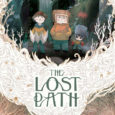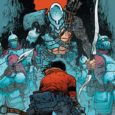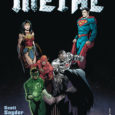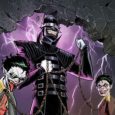After switching to its now bi-monthly release schedule, Doomsday Clock returned last week with Issue #4, which picks up straight after last issue’s cliffhanger ending and focuses on the origin of the mysterious new Rorschach. The story jumps between Rorschah’s previous stay in a mental asylum post-Watchmen and his current incarceration in Arkham Asylum.
Of the two plot lines to follow, the flashback story is the most intriguing. Following the newer Rorschach after the New York attack it’s revealed that not every person exposed to the “alien invasion” died instantly. Many suffered from horrific visions and are left severely traumatized. One of these victims is Reggie, a young man whom writer Geoff Johns wisely connects to the original Rorscach through his relationship to his father. Providing Reggie with an interesting perspective on a character most others consider to be a crazed vigilante.
Symmetry as a theme is present throughout this issue in both the art and writing, with Reggie’s confinement in both timelines mirroring one another and obligatory nods to Walter Kovac’s capture in the original Watchmen. Reggie’s decision to spare Ozymandias towards the end is an example of a man not beholden to the same strict code of his predecessor allowing the character to share many of the same traits but with an added element of unpredictability. Where the story diverges, however, is with the introduction of Mothman.
Mothman is used skillfully by Johns not only to provide a mentor for Reggie, but also as an explanation for how he was able to assume the persona of a new Rorschach and obtain the tools required to confront the man responsible for his parents death.
As a character, Mothman provides a warmth and humour in what would be an otherwise dreary setting. Mothman’s eventual fate is heartbreaking in it’s execution, as are his letters to an estranged sister, which serve as this issues epilogue. This is a character whose inclusion could verge too far towards fan service in another writers hands, but thankfully Johns allows the character to be an essential part of the narrative instead of a throwaway gag or lazy reference.
Another character who arrives in the final few pages is Saturn Girl, something of a reward for fans who have been reading DC Rebirth since its launch. Up until this point, Saturn Girl had only appeared in small cameos, hinting at a connection to the wider Doomsday Clock story. It’s nice to see threads like this finally begin to converge, even if her escape from Arkham could throw up more questions than it answers. The final page delivering an image guaranteed to leave readers discussing its symbolism and implications for the narrative going forward.
It is now a given to say that Gary Frank’s art continues to impress this issue. Mothmans late night flight is the obvious highlight and the overall pacing and detail of each page once again compliments Johns writing perfectly, demonstrating a symbiotic storytelling relationship similar to the one shared by Alan Moore and Dave Gibbons. Frank’s smaller details, such as the halls of Arkham resembling those in The Killing Joke, is a delightful example of these two creators weaving a DC universe intrinsically connected to Alan Moore’s previous work.
Doomsday Clock continues to be THE comic book event of the year. If Geoff Johns and Gary Frank continue this level of quality for the entire run, it’s sure to be considered a modern classic.
In popular culture, Star Trek has always been the thinking man’s sci-fi when compared to the more bombastic Star Wars. Obstacles in Trek are often overcome using logic and the inventive use of technology as opposed to the “shoot X to blow up Y” methods employed by Luke Skywalker and company. So it should not come as too much of a surprise that the Klingon war that has been the overarching plot thread of the Star Trek: Discovery season finale ends with a conversation rather than a battle. However, it’s hard not to feel disappointed. The series up until now has done a commendable job of combining the intellectual mind games of traditional Trek with the fast paced action of the more recent Abrams films. This more muted season finale feels strangely out of place, like a missing episode of the Next Generation.
The finale at times feels like it’s spinning its wheels with too little plot to fill its run time, much of it taking place in a Klingon market with quirky scenes demonstrating how the warrior race spends its free time gambling and frequenting strip clubs. Whilst this is a novel idea, highlighting that the Klingons are not morally black and white but instead various shades of grey just like the Federation, it feels out of place and takes away all the momentum established by the previous episode. It’s difficult to believe that Earth is in danger of imminent destruction when our heroes have time to enjoy kinky sex and hang out with space druggies.
Captain Georgio’s return also feels like a missed opportunity. Having such a ruthless wild card thrown into a war for survival should be a perfect recipe for drama, but instead the character is held back for what will be an inevitable season 2 appearance. It seemed as though the show had already played its best hand with the mid season reveal of Captain Lorca’s identity and has struggled to reach those heights again. Georgio had all the potential to surpass Lorca as the seasons most threatening antagonist but feels neutered by comparison.

Whilst its fitting that our main protagonist Burnham should find a peaceful solution to end the war which she initially caused, it does come across as rather easy and simplistic in execution. The Klingon war machine up until this point has been portrayed as unrelenting and cruel, so to have them so ready to stand down after a single (though potentially devastating) threat felt unearned. Despite this sudden turn around, its is still nice to see Burnham undergo genuine growth as a character and learn that there are sometimes alternatives to meeting aggression with aggression.
The main cast continues to shine, Sonequa Martin Green and Doug Jones’ evolution from comrades to wary opponents to close friends as Burnham and Suru has been a joy to watch over the course of the season, as has the developing maturity from Mary Wiseman as Cadet Tilly. It’s still a stretch to see Shazad Latif as the tough space marine that he is initially presented as but he consistently delivers whenever the scene requires him to show the mental trauma that Tyler has undergone.
The final scene of the Enterprise meeting the Discovery may feel hamfisted for some viewers but combined with the original series score it’s hard not to be nostalgic and excited for where Discovery can go from here. The season overall has been an entertaining ride with more highs than lows and hopefully can go from strength to strength next season, personally I cannot wait for season 2, I just hope the showrunners learn from season 1’s missteps and build upon its triumphs. The potential for a wider exploration of alternate realities or jumps in time provides the writers the opportunity to boldly go……oh, you know the rest.
Like our thoughts on the review? Got some points we missed? Let us know on Twitter @SubCultured!
How do you follow up an almost flawless first issue of Doomsday Clock, that not only established a new status quo for the world of Watchmen but also seamlessly integrated a mystery involving Superman? Don’t forget with art and writing that feels like Moore and Gibbons never left.
Well, if you’re Geoff Johns and Gary Frank, having Rorschach eat Batman’s breakfast isn’t a bad place to start. But we’ll get to that.
Issue #2 of Doomsday Clock picks up right where we left Ozymandias, Rorschach, Marionette and Mime. Sticking with the classic 9 panel grid for most of this opening, we start in Nite Owl’s abandoned basement and are shown two interweaving stories. Mime and Marionette are carrying out a heist gone wrong some time in the past, and Rorschach and Veidt in the present debating the merits of trusting two hardened criminals to save the world.
The arrival of Dr. Manhattan during the heist is a fun unexpected moment that reveals why Marionette is such an integral part of Ozymandias’ plan. Whether or not he’s fully aware of why Manhattan spared Marionette’s life remains to be seen. It certainly appeared that Manhattan was hesitant to kill a pregnant woman. This contrast nicely echoes the Vietnam sequence of the original Watchmen where The Comedian demonstrates he has no such qualms.
Then it’s off to the DC universe without a moment to spare as the Watchmen’s world is nuked into oblivion. This whole segment felt rushed and convenient compared to the rest of the issue. Perhaps I was hoping for a more intricate system for travelling between dimensions than a throwaway of, “Oh, its ok, I’ve installed a new button in the Owl ship”.

However, this is only a minor gripe as I can understand that Johns is more interested in showing how these characters interact with the DC universe than how they get there. What’s more interesting is where the Watchmen initially land, in an almost exact reproduction of the funfair from The Killing Joke. It’s a nice nod to Alan Moore’s other DC work and potentially an indication of the way Johns intends to characterize Batman and the Joker for the rest of the story.
Here is where our team splits, as Ozymandias and Rorschach attempt to recruit Bruce Wayne and Lex Luthor to their cause, whilst Mime and Marionette are restrained aboard the Owlship. At this point, Gary Frank’s art goes from good to great, as we are treated to some brilliant visual storytelling, mixing Watchmen inspired visual cues with Geoff Johns’ humour and wit. The Owlship bursting through the Bat Symbol and Rorschach’s exploration of Wayne Manor are particular highlights. Rorschach being distracted by a free breakfast leading to him notice a tell tale breeze under the grandfather clock is an amusing and appropriate way for that character to unearth Bruce Wayne’s big secret.
Ozymandias on the other hand has less luck convincing Luthor, who has reverted back to his evil business tycoon demeanor that readers have not seen since before Forever Evil. Luthor questioning Ozymandias’ intelligence after having the plot of Watchmen explained to him feels like Johns winking to the reader about the more ridiculous aspects of that series finale.
We are then left with not one, but three, cliffhangers as a seemingly resurrected Comedian attacks Luthor, Mime and Marionette escape into Gotham City, and Rorschach is confronted by a hungry Batman. Hopefully the Comedian’s appearance is not all it seems, as I feel that bringing back this character undermines the importance of his murder in the original Watchmen. Perhaps it’s tied to Ozymandias brain tumor. We can only wait and see.
Overall, this issue continues the high quality established by the first, with John’s doing an admirable job of echoing the writing style of Alan Moore and Gary Frank bringing beautiful and inventive imagery to every page. My only negatives being the protagonists convenient journey to Gotham and the reappearance of the Comedian, though these do not detract from the story overall. I look forward to seeing where this story goes next and how one gruff vigilante will come to terms with another gruff vigilante eating his pancakes.


















